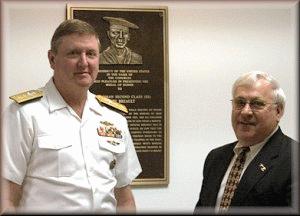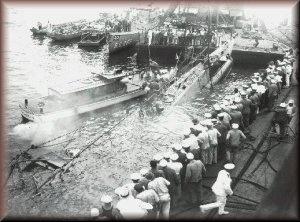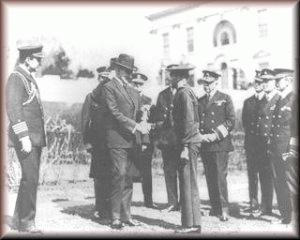|
Presented here for informational and educational purposes only |
| It was shortly after six in the morning,
October 18, 1923, when the US Submarine O-5 and a 5,000 ton freighter owned
by United Fruit, SS Abangarez, collided in the waters near Cristabol, Panama
City and O-5 sank in six fathoms of water in less a minute.
Two days later the bodies of Metzler and Smith were found floating in the sea off the Colon breakwater. Hughes was never seen again. Rescue work started almost immediately. Navy divers arrived and surveyed the sunken submarine. Their raps on the O-5's hull brought immediate response from inside -- Breault and Brown were alive in the forward torpedo room. But the divers were helpless to rescue the trapped men. Artificial lungs and rescue chambers to enable men trapped in a submarine to escape had not been invented. The only on-hand resource to rescue the trapped sailors were giant cranes to lift the submarine from the bottom. After two failed attempts, after thirty-one hours on the bottom, O-5's bow broke the surface and when the hatch was clear, Breault and Brown crawled out, more dead than alive.
It was for Breault's act of selflessness and valor by going to the assistance of his shipmate, though realizing the O-5 was doomed, that he was awarded the Congressional Medal of Honor by President Calvin A. Coolidge on March 8, 1924. |
 In
ceremonies at Groton's Naval Submarine School, Putnam's Mayor, the Honorable
Daniel S. Rovero joined Rear Admiral Paul F. Sullivan, Director, Submarine
Warfare Division and the school's Commanding Officer, Captain Arnold O.
Lotring, in unveiling a plaque commemorating Breault's bravery and celebrating
his achievement as the first, and only enlisted submarine Sailor to receive
the Congressional Medal of Honor. In
ceremonies at Groton's Naval Submarine School, Putnam's Mayor, the Honorable
Daniel S. Rovero joined Rear Admiral Paul F. Sullivan, Director, Submarine
Warfare Division and the school's Commanding Officer, Captain Arnold O.
Lotring, in unveiling a plaque commemorating Breault's bravery and celebrating
his achievement as the first, and only enlisted submarine Sailor to receive
the Congressional Medal of Honor.
Naval Submarine School staff, working with submarine historians from across the nation, to include James Christley, hope to develop a full display of photographs and documents celebrating the life and career of Putnam's Native Son, Henry Breault. Photographs contributed by David Bretter |
 Sixteen
crewmen were rescued immediately but five were missing. They were: Henry
Breault, torpedoman second class; Lawrence T. Brown, chief electrician's
mate; Clyde E. Hughes, motor machinist's mate first class; Thomas T. Metzler,
fireman first class; and Fred C. Smith, mess attendant, first class.
Sixteen
crewmen were rescued immediately but five were missing. They were: Henry
Breault, torpedoman second class; Lawrence T. Brown, chief electrician's
mate; Clyde E. Hughes, motor machinist's mate first class; Thomas T. Metzler,
fireman first class; and Fred C. Smith, mess attendant, first class.
 It
was only after the rescue that the world learned of the heroism below the
waves. Breault, 23, of Putnam, Conn., was in the forward torpedo room at
the time of the collision. He escaped to the main deck, but then realized
his friend, Brown, was asleep in the forward battery room. Breault went
back into the sinking submarine, closing the hatch cover as he slid below.
Brown had not heard the order to abandon ship. With water charging in on
them, they attempted to escape through the conning tower, but the deluge
blocked that route. They struggled back into the torpedo room and forced
shut its water-tight door as the O-5 hit bottom.
It
was only after the rescue that the world learned of the heroism below the
waves. Breault, 23, of Putnam, Conn., was in the forward torpedo room at
the time of the collision. He escaped to the main deck, but then realized
his friend, Brown, was asleep in the forward battery room. Breault went
back into the sinking submarine, closing the hatch cover as he slid below.
Brown had not heard the order to abandon ship. With water charging in on
them, they attempted to escape through the conning tower, but the deluge
blocked that route. They struggled back into the torpedo room and forced
shut its water-tight door as the O-5 hit bottom.